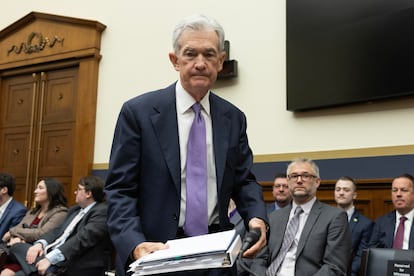Investors resign themselves to less aggressive rate cuts in the United States
The Federal Reserve is expected to maintain the price of money at 5.25%-5.5% on Wednesday and to update its forecasts for the end of the year


Wait and see. That is the attitude that the chairman of the Federal Reserve, Jerome Powell, has adopted for months. Investors are anxious and analysts are exchanging wagers, but the fact remains that the U.S. central bank has not touched interest rates since July of last year. Nor will it do so at this Wednesday’s meeting, according to all forecasts. The attention is focused on something else instead: the clues offered by Powell about when the rate cuts will begin, and the economic projections by the members of the Federal Open Market Committee (FOMC). Persistent inflation has pushed away the likelihood of rate cuts, and investors are now resigned to a less aggressive rate-cutting policy than they expected just two months ago. The message about higher rates for longer that came out of the Jackson Hole seminar last summer has now become a reality.
The price of money is currently at 5.25%-5.5%, its highest level in 23 years. At their quarterly meetings, FOMC members discuss what they believe will be the appropriate monetary policy going forward, making predictions about where they believe it is most likely that the federal funds interest rate will have to be to meet the double legal mandate of promoting maximum employment while keeping prices stable.
Last December, the median of these predictions pointed to a rate cut of 0.75 points this year, to 4.625% (or in other words, to the range of 4.5%-4.75%). A few months ago, some expected that the first cut would come at this meeting. However, the strength of the labor market and a failure to bring inflation down to the 2% target have led Powell to rule out imminent cuts.
The stock market gets over it
Futures market quotes show that the market is at this point expecting those same three rate cuts of 0.25 points this year. Just a few months ago, investors were betting on more aggressive cuts in anticipation of the economy losing strength and inflation falling faster. The new landscape has had an impact on fixed income, but the stock market has nevertheless been able to climb to highs.
The FOMC forecasts have a qualified value because the people who formulate them are basically also the ones who have to make the decisions, although they frequently deviate from reality. The 19 members of the committee can express an opinion, not just the 12 with the right to vote. The first focus of attention on Wednesday will be to see if the 0.75 point reduction forecast is maintained, after inflation rose to 3.2% in February.
“February’s consumer price index will not instill further confidence among Fed members that inflation is on a sustainable path toward its 2% target, reducing our subjective odds that the central bank will cut interest rates in its May meeting,” Oxford Economics analysts pointed out after the publication of the data. “While on its own, [the data] may not be enough to prevent the Federal Reserve from cutting rates by mid-year, it should raise real questions about the extent to which inflation will return to target in the absence of further easing in the labor market,” said Tiffany Wilding, an economist at Pimco. Job creation remains robust, although the unemployment rate has risen to 3.9%.
Powell has declared himself dependent on the data. To get a better picture of what’s happening in the economy, he’ll probably want to wait. The monetary policy meeting on April 30 and May 1 will have few new ingredients in the shaker and most investors are already setting their sights on the last meeting of the spring, June 11 and 12.
Election year
In his last speech in Congress, Powell made it clear that he is in no hurry. With a cautious “probably,” he admitted that rates have peaked. At the same time, he assured that if the economy evolves in line with expectations, it is likely that at some point this year it will be appropriate to start lowering rates. But Powell also noted that the target of 2% inflation has not yet been reached and that success is not guaranteed. Therefore, he warned against both the risk of relaxing monetary policy too much or too soon and against doing so too little or too late.
In an election year, the Fed’s decisions are going to be analyzed with a magnifying glass. Democrats are urging Powell to lower rates and Donald Trump has accused him of planning to do so to facilitate Joe Biden’s re-election. “We don’t think about politics. We think about what is right for the economy,” the Fed chief replied in December.
The recent Odysseus mission showed how complicated a soft landing on the moon is. Recent history shows how difficult this is to achieve as well in economics, which borrowed the term from the space race and gave it its own meaning: controlling inflation without causing a recession.
A year ago, economists were using a recession as their central scenario. Now, a soft landing seems possible, but not guaranteed. Tom Barkin, president of the Richmond Federal Reserve, pointed out four risks at the beginning of the year: “The U.S. economy could run out of fuel. We could experience unexpected turbulence. Inflation could level off at a cruising altitude higher than our 2%. And the landing could be delayed as the U.S. economy continues to defy expectations.”
Sign up for our weekly newsletter to get more English-language news coverage from EL PAÍS USA Edition
Tu suscripción se está usando en otro dispositivo
¿Quieres añadir otro usuario a tu suscripción?
Si continúas leyendo en este dispositivo, no se podrá leer en el otro.
FlechaTu suscripción se está usando en otro dispositivo y solo puedes acceder a EL PAÍS desde un dispositivo a la vez.
Si quieres compartir tu cuenta, cambia tu suscripción a la modalidad Premium, así podrás añadir otro usuario. Cada uno accederá con su propia cuenta de email, lo que os permitirá personalizar vuestra experiencia en EL PAÍS.
¿Tienes una suscripción de empresa? Accede aquí para contratar más cuentas.
En el caso de no saber quién está usando tu cuenta, te recomendamos cambiar tu contraseña aquí.
Si decides continuar compartiendo tu cuenta, este mensaje se mostrará en tu dispositivo y en el de la otra persona que está usando tu cuenta de forma indefinida, afectando a tu experiencia de lectura. Puedes consultar aquí los términos y condiciones de la suscripción digital.
More information
Archived In
Últimas noticias
Welcome to the post-religion era: The idea of Christianity as the absolute truth has become obsolete
‘I thought you would like it’: The risky sexual practice popularized by TV shows and TikTok
The digitalization of tourism: ‘They promise experiences and gave us the worst possible one’
Mexican peso defies uncertainty with forecasts of a new period of stability in 2026
Most viewed
- Sinaloa Cartel war is taking its toll on Los Chapitos
- Reinhard Genzel, Nobel laureate in physics: ‘One-minute videos will never give you the truth’
- Oona Chaplin: ‘I told James Cameron that I was living in a treehouse and starting a permaculture project with a friend’
- Why the price of coffee has skyrocketed: from Brazilian plantations to specialty coffee houses
- Silver prices are going crazy: This is what’s fueling the rally










































